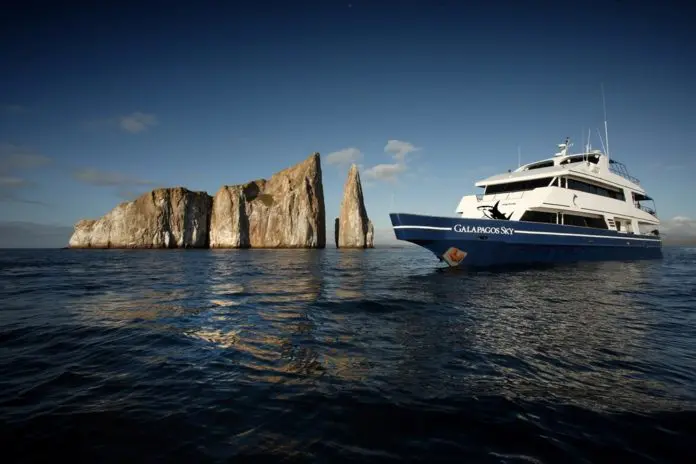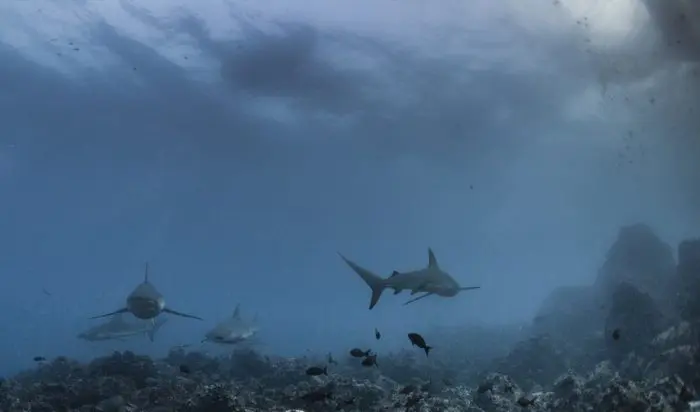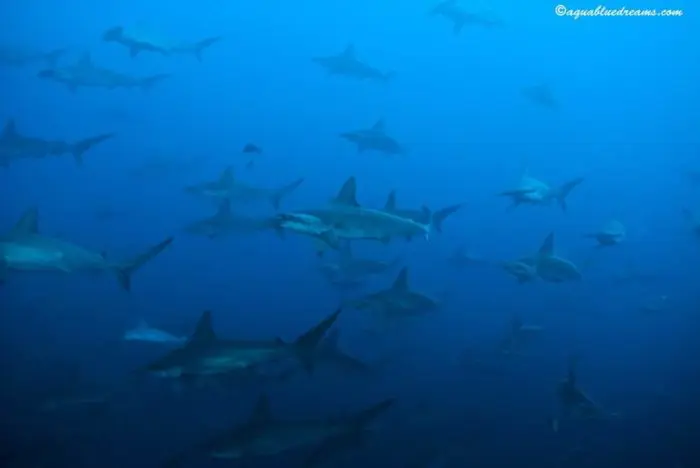Words and Photographs by John McIntyre
Two names conjure a spectacle of unrivalled, on-the-edge diving. They are Darwin and Wolf, two volcanic islands instantly recognisable as the jewels in the Galapagos archipelago.
As someone who has dived in all corners of the world, I am often asked: “Where is the best place you have ever dived?”
It’s not easy. I love the Red Sea, having made more than 1,000 dives there alone; I think the Maldives are stunning; the Great Barrier Reef is a colourful joy; the Sardine Run in South Africa is stupendous. But one single dive in the Galapagos was probably the most-exhilarating of all.
It came near the end of one of my greatest liveaboard experiences as a guest of DivEncounters and Scuba Travel on board Galapagos Sky, a boat whose understated attention to detail and professionalism takes diving to a whole new level.
The diving is challenging to say the least. GPS emergency beacons, air horns, reef hooks and a good level of dive fitness are prerequisites for coping with the swells, surges and currents swirling through the volcanic undersea topography, at times like a washing machine cycle.
Thankfully, the water temperatures here are a fairly comfortable 25 degrees C or so. We knew we would see scalloped hammerhead sharks; we’d seen them on virtually every dive by then. Other sharks – Galapagos, blacktips and silkies – rays, turtles, morays and large schools of jacks were by now a familiar sight as well.
This particular dive was in the turbulent waters swirling around the famous arch of Wolf Island. After making a rapid descent to make a grab for the nooks and crannies in the rocky boulders making up the reef, we soon settled into the routine of staying put, taking in the spectacle and then moving on again. Or should I say being swept along with little choice. On this one dive, it was as though the armies of marine life had decided to put on a show to end all shows. It started with a smattering of sharks, fleeting schools of jacks, the odd passing Galapagos reef shark and the near-horizontal stream of bubbles from divers working their way along what felt like a moving wall of water, bursting with nutrient-rich energy and life.
At various intervals, it was all we could do to remain in sight of the rest of the dive group. But as the dive went on, we decided simply to soak in the scenery as we were bombarded with encounters of hammerhead sharks in every direction – below, above, directly ahead, all around. The building-sized schools of trevally remained passive as we were swept along on a magical undersea ride. A massive school of tuna appeared out of nowhere, heading in the opposite direction to us. Galapagos reef sharks that looked like they were on steroids cared less about the awkward visitors releasing an endless stream of bubbles with such a vital natural food source in relentless supply.
For as long as the dive lasted, not a second was void of an encounter which on its own would make any other dive worthwhile in itself. This was a dive like no other and as we surfaced nearly a mile from our entry point, we were buzzing with the excitement of a shared experience that would keep us talking about it long after dinner that night.
The images also helped bolster the underwater sequence for the short film I was making for the BBC World television programme Fast:Track, to which I’m a regular contributor.
I travelled to the Galapagos with veteran divers and tour operators Tony Backhurst (Scuba Travel Worldwide Holidays) and Peter Hughes (DivEncounters), both of who have long-earned their respect within the industry and among tourists as setting gold standards for liveaboard diving around the world.
Of all the destinations, the Galapagos had been on my ‘bucket list’ for many years. Now that Peter had become involved in DivEncounters, an alliance of owners of some of the best boats in the world, I decided to turn my ambition into a reality.
Anyone who loves diving – and especially shark encounters – understands the pull of these magical islands. Ever since Charles Darwin developed his theory of evolution here, the Galapagos have come to epitomise everything that is adventurous travelling. The diving, too, has a legendary reputation.
Darwin’s legacy is a protected national park with world heritage status. For my BBC report, I wanted to reflect how the national park was dealing with the massive increase in tourist numbers. They have soared from a few thousand in the 1960s to more than 170,000 who now pile onto boats heading out to the major islands every year. In fact, tourists spend over $100 million a year here, which is why the new threat comes not so much from tourists as locals coming here from the mainland looking for work. This has led to heightened concerns about the need to eradicate introduced or invasive species to ensure the long-term survival of native wildlife.
In basic terms, new regulations have been brought into force limiting land-based excursions for dive boats, while restricting the land-based tours to more-rigorous itineraries spread over 15-day intervals.
Like a lot of operators, Peter was disappointed at first but says he understands that the Galapagos are an international treasure under great pressure that need high levels of protection.
After the long, seemingly unending flying from Blighty, via Ecuador, we finally arrived at San Cristobal, where the crew of Galapagos Sky greeted us with the sort of enthusiasm and professionalism that bode well for the week ahead. It’s funny how, no matter how much flying I do, I feel like an excited child whenever I first set eyes on a destination which is a long-cherished dream. It was Tony’s first time, too, and we were both brimming with a sense of eager anticipation.
Sea lions lounging on the rocks, including a suckling mother and pup, expertly fishing pelicans and the odd marine iguana baking in the sun made us realise we had indeed arrived in Darwin’s timeless wildlife laboratory.
Once on board, it was clear the level of service was geared towards satisfying the market for high-end tourism, especially for Americans prepared to pay top dollar for the ultimate diving experience. This 33-metre yacht has been truly equipped to the hilt, with a well-thought out dive deck offering nitrox, showers, a large camera area with air guns to dry off, a constant supply of hot and cold drinks, all served with a smile – and food of an exceptional quality. You even get a menu. It’s also run democratically. The captain is just as likely to offer you a warm towel and drink after a dive as any other crew member. This really is a tightly run operation, with safety and service uppermost.
As is required by local laws, at least one dive guide is also a park ranger. They know the islands and waters extremely well.
So to our first dive, in the shallow sandy waters off Santa Cruz, where the water temperature was a shivering 18 degrees C. I’d scrounged a 7mm for the occasion and, boy, did I need it. Those who dared to risk 5mm suits came out shivering, covered in goosebumps. But the experience was quite extraordinary. Within minutes of entering the water, the large, lumbering lumps of blubber that barely moved on the rocks above the surface turned into agile, torpedo-like masters of the sea. Now the tables were turned. It was us in our cumbersome scuba gear providing the spectacle and amusement for these graceful marine mammals. But be warned. Those teeth can inflict a painful bite and neoprene provides little defence. They’re only treating you the same as they treat each other. Peter took quite a nip on the head as they played with us. But the experience more than whetted our appetite for the diving to follow.
Before pushing on to the mega sites at Darwin and Wolf, we were allowed a brief trip on land. After all, no trip to the Galapagos would be complete without seeing at least one giant tortoise. This is where ranger experience and local knowledge comes into its own. I had only two hours to locate and film at least one of the 18,000 or so of these legendary residents. Hard to believe that they live to more than 150 years, or put another way, older than every single person on earth at any one time.
Turns out that seeing them at first light is not exactly the best time for filming purposes. They are slow movers at the best of times, but in the morning a barely perceptible movement of the head is about as exciting as it gets. Nevertheless, the shot with the giant tortoise is mandatory in television terms and our guide found a suitable candidate within a short time. Job done.
And so to the crème de la crème of the diving world. We set off overnight to the warmer waters of Darwin and Wolf, legendary hotspots ranked alongside the likes of Cocos and Malpelo for hammerhead sightings. I’d been to Cocos a decade earlier and witnessed the unforgettable silhouettes of schooling hammerheads at Alcyone in numbers too great to count.
Armed with a camera weighing in at around 20kg-plus, this was going to be interesting. I was given a reef hook to help. Luckily, the surface conditions when we arrived at Darwin were relatively calm. At certain times of the year the seas can howl. But it’s the volcanic topography combined with powerful, nutrient-rich currents that create the perfect environment for this unique marine eco-system.
It took a few dives to get used to the currents, combined with surges that rocked back and forth, with the added problems of the drag caused by such a large camera housing.
But this is a place where you find your spot, wedge between some rocks, hook on, and wait for the wildlife to come to you. My bubbles might have been heading off one way but the sharks effortlessly glided within range. Hardly a moment of the dive went by without a hammerhead or small school of hammers swimming past. Turtles, morays, large schools of jacks and passing eagle rays also abounded at the numerous cleaning stations. As we were split into two groups, perhaps the only disheartening thing for me was that one of the groups could hardly contain themselves after a large tiger shark made a brief appearance. Another contingent saw a whaleshark while surfacing. Anything can turn up here.
For me, the imagery that I most wanted to capture was the famous wall of hammerheads. This actually meant remaining fairly shallow – no more than 10m – for about 20 minutes until we reached a large expanse of sand sloping down to 40m-plus at Darwin. This seems to be a favourite place for sightings. On the third attempt, the wall appeared. The sharks gathered here in their hundreds and though receding into the gloom, they duly obliged in providing a spectacle to represent the wonders of the Galapagos.
Around the islands, scientists have placed beacons to monitor a number of tagged sharks. This is in the face of the constant battle to fight illegal fishing. It does seem for now at least that around Darwin and Wolf, the shark populations are holding up.
On another dive, we treated to large schools of mobula, cow-nose rays, and a brief but delightful display by manta rays towards the end of a drift over the rocky shallows. Along the way, the distractions are ever-present, whether a big school of barracuda or the ubiquitous black-striped salema and the beautifully blue-coloured king angelfish.
In between dives, the melee of leaping spinner dolphins added to the charm of Darwin and Wolf.
We passed the equator a few times during our week on Galapagos Sky, moments shared by the rest of the guests and crew as we watched the GPS on the bridge countdown to a row of zeros.
Dining on board was among the best I’ve enjoyed on any liveaboard, served in a style as befitting any floating gourmet restaurant. Likewise, briefings were detailed and assuring, especially as safety is taken very seriously. But fear not, if you’re not exactly Olympic-swimming material. Not everyone on board had svelte-like wetsuit-hugging figures to die for. And everyone coped pretty well, given the level of difficulty.
It’s astonishing how large the temperature change is given the proximity to the equator, but back at the colder Punta Vicente Roca, we once again squeezed into as many layers of neoprene as we could manage, carrying enough lead to sink a battleship.
A pod of killer whales, one with a giant dorsal at least a metre high, got our hearts racing. They’d just made a kill a few hundred metres from our boat. Alas, they were gone before we piled into the RIBS.
We think they may have taken a mola mola, so often found at this site. A few in the group saw them in the greener, murkier depths at around 30m.
The sizzling waters around the volcanically active fumeroles provide yet another dimension to the undersea topography, bubbling away in the nutrient-rich waters while the sea lions dart around divers at great speed.
On the surface, the prehistoric-looking marine iguanas and equatorial penguins are a constant reminder that this is somewhere special, somewhere worth protecting at all cost.
I wonder what Darwin would have made of his extraordinary legacy, not least had he been able to see for himself the momentous wildlife below the surface. The Galapagos truly is the diving destination of a lifetime.






